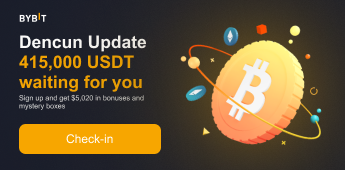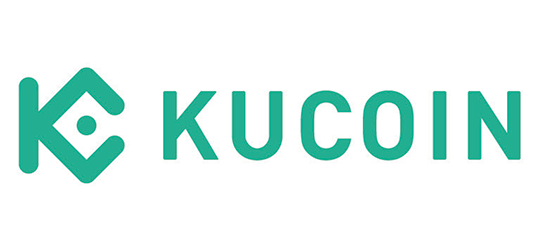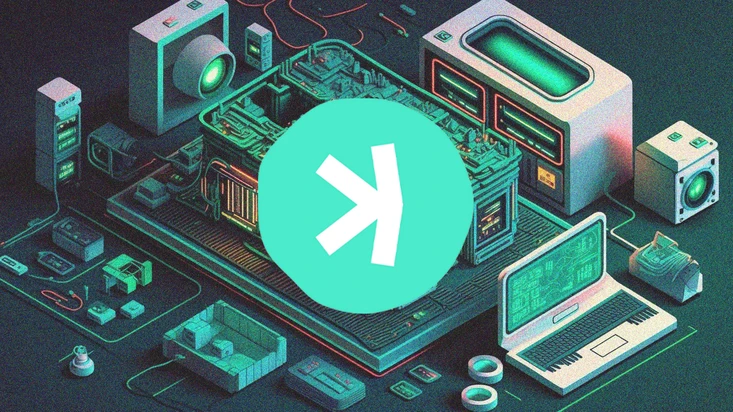
How to Mine Kaspa?
Did you know that mining Kaspa can bring a return? Are you curious about Kaspa's features and what makes the KAS coin so profitable? What technology lies at the foundation of the Kaspa blockchain? In this comprehensive guide, we will lead you through the essential steps of Kaspa mining.
How to mine Kaspa?
Have you heard about Kaspa? Are you aware that mining the Kaspa token KAS can be profitable? Well Mining Kaspa can be a rewarding both for individual miners who are willing to invest in hardware or those who choose to join a mining pool. Before delving into the specifics, let us first cover some basics that will aid in understanding the technology behind this project.
Kaspa (KAS) is a blockchain that prioritizes speed and scalability, using a proof-of-work consensus. It is a blockchain with an instant validation transaction sequencing layer that has the capability of facilitating high block rates while also being able to preserve a high level of security that is available through PoW consensus.
Kaspa is based on the GhostDAG (Greedy Heaviest Observed Subtree Directed Acyclic Graph) protocol, a unique technology which is a scalable generalization of the Nakamoto Consensus (Bitcoin consensus). Its design is faithful to the principles that Satoshi embedded into Bitcoin which helps to achieve achieve high scalability and fast transaction processing.
According to the Kaspa website, the platform is capable of processing up to 32,000 transactions per second, making it one of the fastest blockchain networks in existence. This speed is achieved through the use of GHOSTDAG, which allows Kaspa to process multiple transactions in parallel, rather than in a linear fashion like traditional blockchains.
Unlike other cryptocurrencies, Kaspa doesn't throw away any parallel blocks created during transactions. Instead, it keeps them all and organizes them in a way that everyone agrees upon. This way of organizing transactions is called a blockDAG. You can actually see this happening in real-time using a special visualizer tool.
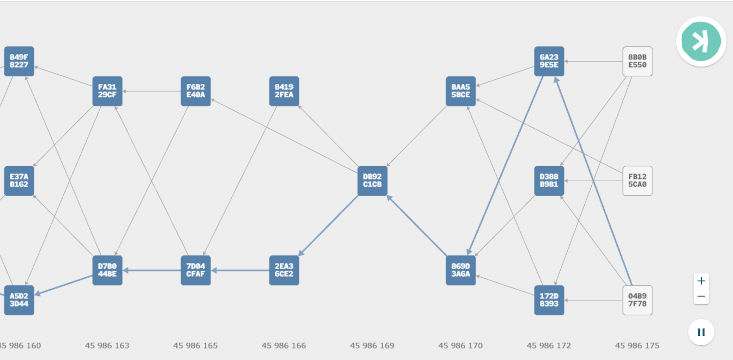
Source and Copyright: © kaspad.net
Tech savvies curious about how the Kaspa blockchain works might want to explore the project’s white paper. Now let’s move to the real deal and explore how to mine Kaspa.
Disclaimer. Before mining cryptocurrencies, be sure to check the legislation and find out if cryptocurrency mining is allowed in your country.
Similar to other cryptocurrencies, KAS coins play a crucial role in fueling the platform and motivating users to uphold the data integrity. KAS distinguishes itself by offering transaction fees and developer payments, making it valuable for those who contribute to the network. Miners who operate nodes receive rewards proportionate to their contributions. The network processes transactions in just one second, so it doesn't require excessive power to support numerous hash functions. Consequently, miners can realize a profit quickly using the decentralized blockDAG.
As of now, Kaspa is said to be the fastest proof-of-work mineable coin available while remaining decentralized. The blockDAG framework and swift block rates promote greater mining decentralization, enabling efficient solo mining at lower hashrates. The coin launched with fairness in mind in November 2021, without any pre-mine, pre-sales, or coin allocations. Kaspa is 100% community-managed, open-source, and decentralized.
Kaspa mining relies on kHeavyHash, a modified version of the "optical-miner" optimized HeavyHash algorithm. kHeavyHash involves matrix multiplication framed into two keccacs (a type of hash function), making it energy-efficient and core-dominant.
Kaspa can be mined solo or mined as part of a pool. Solo mining requires setting up a mining node. Mining pools are groups of miners who collaborate on Kaspa mining tasks and share rewards accordingly.
It is important to keep in mind that mining Kaspa, like any other cryptocurrency, involves risks and costs. The rewards earned through mining can vary depending on several factors, including the network difficulty, the number of miners in the pool, and the market price of Kaspa tokens.
Obtain Suitable Hardware
Kaspa is a cryptocurrency that uses a modified version of Bitcoin's protocol. Unlike Bitcoin, Kaspa is ASIC-resistant, which means it can be mined using graphics processing units (GPUs) and central processing unit (CPU). GPUs are the same type of chips used in gaming computers. By using mining software on your GPU, you can help verify transactions on the Kaspa network and earn Kaspa coins as a reward.
CPU mining is a way of earning cryptocurrency by using the central processing unit (CPU) of your computer. It involves running mining software on your CPU to help verify transactions on a cryptocurrency network and earn rewards in the form of that cryptocurrency.
However, CPU mining is not as efficient as CPUs are not specifically designed for this task and may not have the necessary processing power to compete with other miners. The Kaspa official Wiki page states that “CPU mining is no longer justified. Better mine Monero, sell it, and buy Kaspa for that money, this way you'll get much more Kaspa in the same time period”
Kaspa mining relies on the KHeavyHash algorithm, which is an energy-efficient algorithm that does not require GPUs with a huge memory capacity. Although the latest generation of graphics cards is recommended for efficient Kaspa mining, you don't need high-end GPUs with large memory.
There is a wide range of mining hardware available on the market that can be tailored to your specific needs and budget both GPU and CPU. Users can check the hardware metrics like profitability, electricity costs, power usage, and efficiency here and make an informed decision
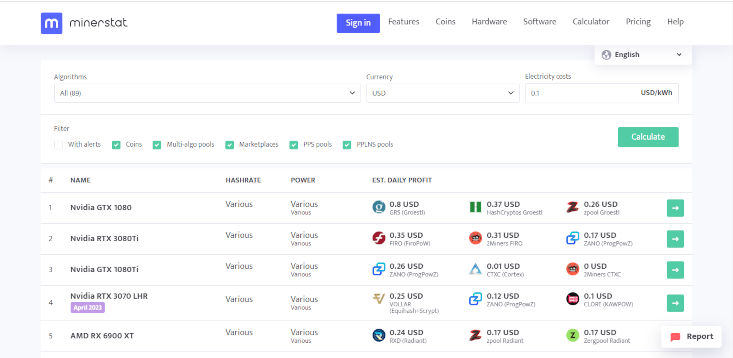
Source and Copyright: © minerstat.com
Kaspa official Wiki page also contains a list of recommended hardware for both GPU and CPU mining along with the hashrate info.

Source and Copyright: © wiki.kaspa.org
Obtain a Wallet Address
Whether you are mining solo or in a pool, first you need to set up a wallet to receive mining rewards and store your KAS tokens. The wallet controls the user's private and public keys (addresses) generation, and storage, and provides the user transaction initiation mechanisms.
Currently, there are 3 different types of wallets available: Kaspa Web Wallet, Desktop wallet, and Kaspa Command Line Wallet. Kaspa also supports third-party wallets like Zelcore Wallet, Tangem Wallet, and Chainge Finance.
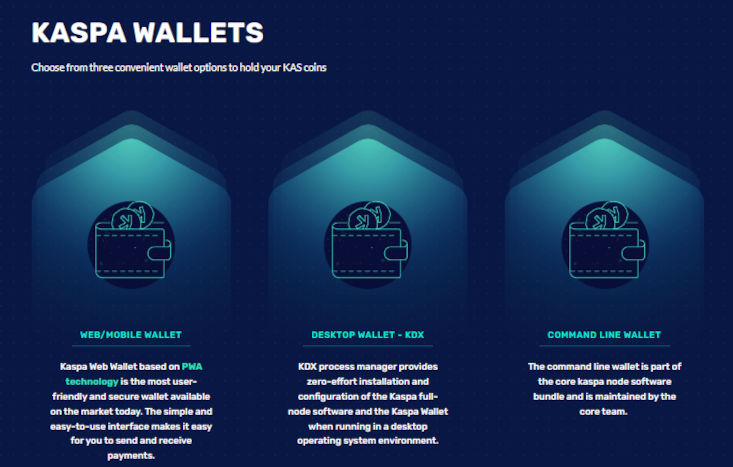
Source and Copyright: © kaspa.org
We will guide you through the Kaspa Web Wallet configuration process as this wallet is the most user-friendly. The setup process is easy and straightforward.
Setting up a desktop wallet is also easy, it requires downloading Kaspa KDX file (Kaspa Desktop eXperience) and installing it on your device. Installing Kaspa Wallet through the command line requires some technical knowledge. The full guide can be found here.
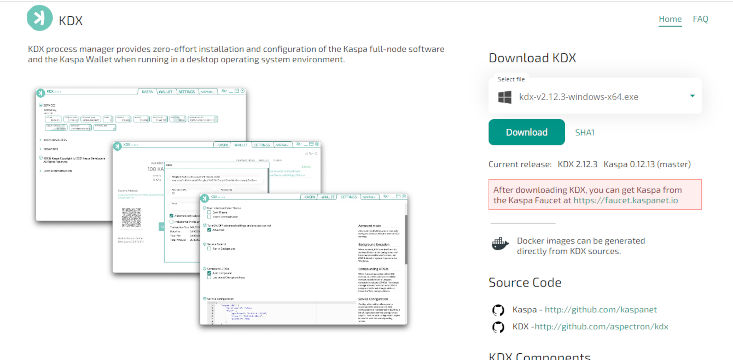
Source and Copyright: © kdx.app
So, let's get started with Kaspa Web Wallet. First, go to https://wallet.kaspanet.io/ and click Create New Wallet
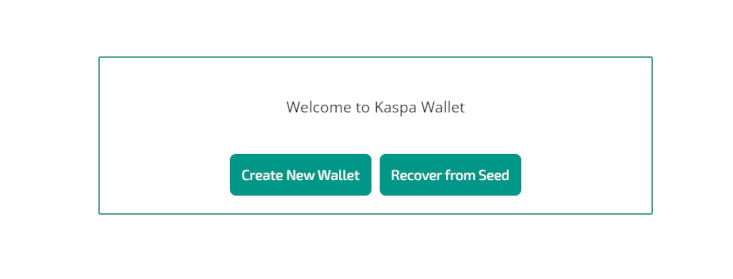
Source and Copyright: © wallet.kaspanet.io
Generate a password and click confirm.

Source and Copyright: © wallet.kaspanet.io
Next, you will see your confidential 12-word seed phrase. Remember to store your seed phrase in a secure location. In the future, you will need this to restore your wallet. Click next.
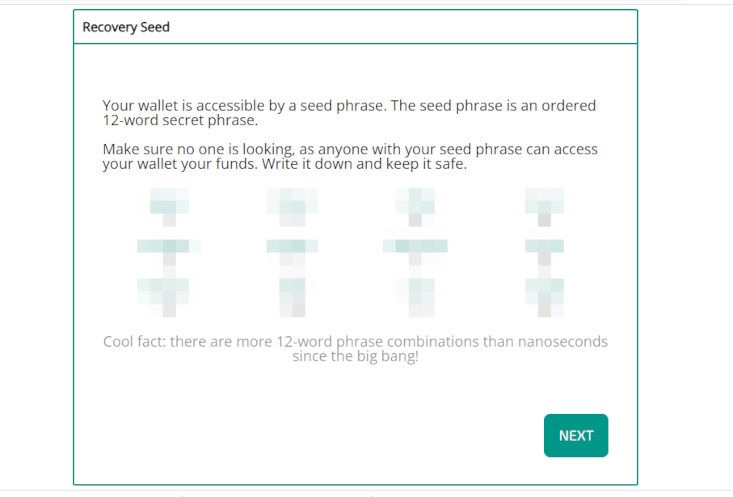
Source and Copyright: © wallet.kaspanet.io
You will be prompted to verify the recovery phrase on subsequent displays. Verify the correct words and then select Done.
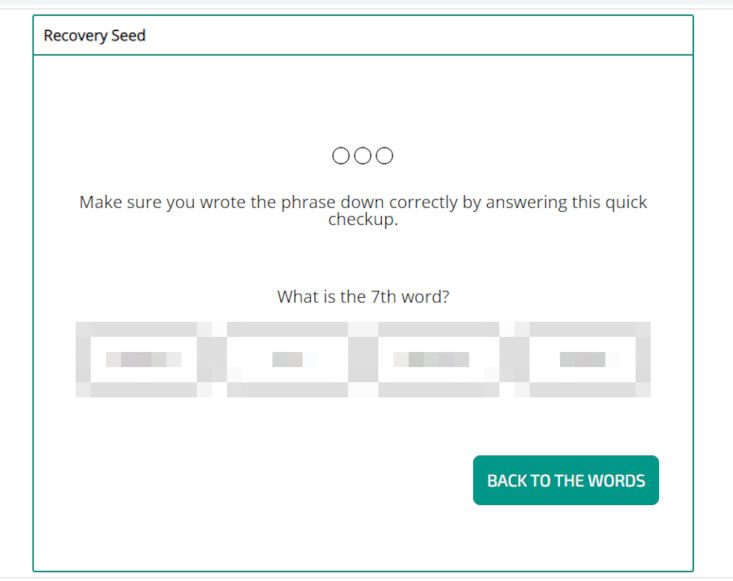
Source and Copyright: © wallet.kaspanet.io
That’s it! You’re done setting up the Kaspa wallet. Copy the Kaspa address which you’ll be using to receive mining payouts and to hold your KAS. Note that Kaspa address contains the word “kaspa”. When sending or receiving payments or even when using it in the miner setup you need to include the kaspa: prefix.
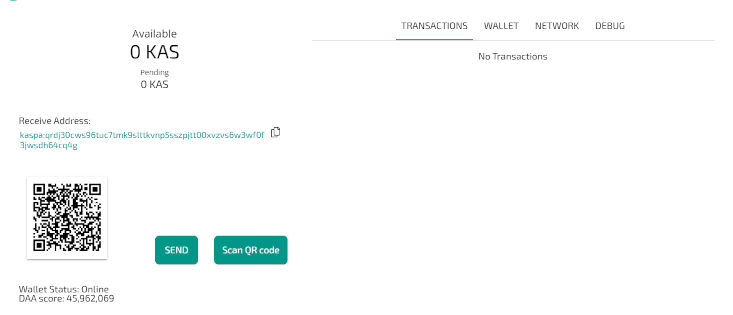
Source and Copyright: © wallet.kaspanet.io
Sign up for an Account
If you chose to join a mining pool, you need to select one and sign up for an account. Popular Kaspa mining pools include 2Miners, Hashpool.com, Kryptex. The full list of mining pools supported by Kaspa can be found here https://miningpoolstats.stream/kaspa
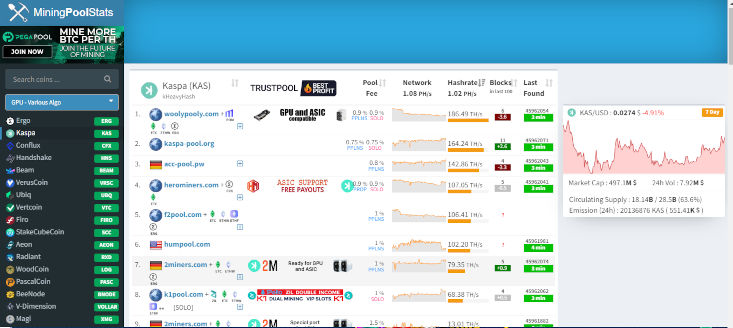
Source and Copyright: © miningpoolstats.stream
Once you made up your mind you need to choose and set up a mining software
Configure Mining Software
There are a number of mining software to choose from, here is the list of GPU mining software supported by Kaspa suitable for solo and pool mining with the respective github links to get started.
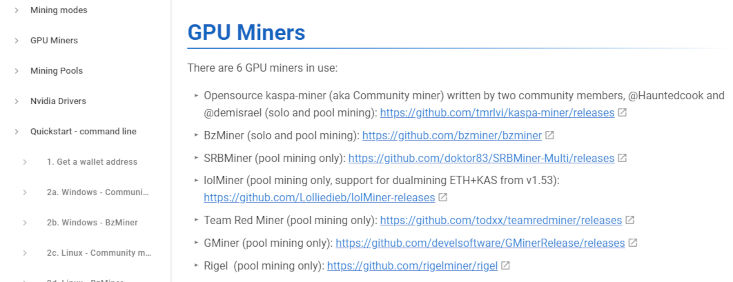
Source and Copyright: © wiki.kaspa.org
The process of setting up a particular mining software may vary, but generally, it includes:
1. Downloading and unpacking the software. Within the folder, you’ll find the reference script. (kaspa.bat for Windows and kaspa.sh for Linux).
2. Right-click and edit mine_kas.bat, and add your wallet address (replacing kaspa:0000)
3. Double-click mine_kaspa.bat.

Source and Copyright: © wiki.kaspa.org
Then add your Kaspa wallet address, configure the pool, and start mining.
KASPA Mining Specifications
Kaspa is a cryptocurrency that stands out due to its fast Proof of Work (PoW) mining. Its block DAG architecture allows for decentralized mining and makes it possible to mine solo even with low hashrates. Another advantage of Kaspa over most PoW coins is that it can be dual-mined with other PoW coins, particularly those that are memory-intensive such as ETH, ETC, and Ergo. However, it is important to note that dual mining requires more energy than mining a single coin. Kaspa has a total supply of 28.7 billion KAS and its emission schedule halves once per year. Below are the technical specifications.
• Max Supply: 28.5B KAS
• Current Block Reward: 415 KAS
• Circulating Supply: 12.4B KAS
• Consensus: Proof of Work, Block DAG
• Hashing Algorithm: kHeavyHash
• Ticker: KAS
• Block time: 1 second
• Launch Date: November 7, 2021 (no pre-mine, no pre-sale, no allocated coins)
KASPA Exchanges
Currently, there are 13 online exchanges available with the Kaspa/USDT trading pair, according to Kaspa official website. Users may also use the native exchange wallet address (kaspa) to receive mining rewards and store KAS.
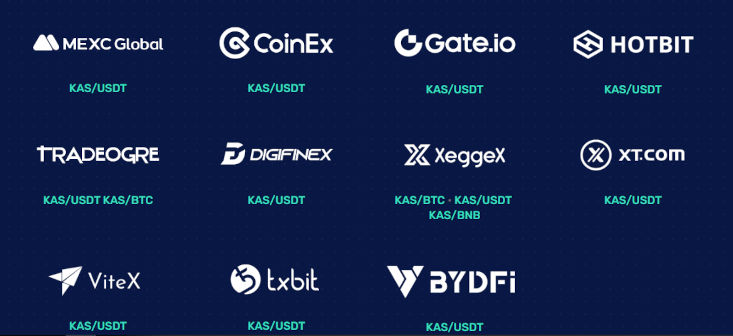
Source and Copyright: © kaspa.org
Dual Mining ETC + KAS
Users may also try dual mining KAS with ETH or ETC. Dual mining is the process of mining two different types of cryptocurrencies at the same time using the same mining hardware. This means that while you are mining one cryptocurrency, you are also simultaneously mining another cryptocurrency with the same GPU. Dual mining is typically done to increase profits and maximize the use of mining hardware. However, dual mining can consume more power and generate more heat, which can affect the lifespan of your GPU.
When dual-mining ETH or ETC and Kaspa, you need a wallet and mining pool for both coins. Use the Kaspa web wallet for the Kaspa wallet. For ETH or ETC addresses, either Trust Wallet or Metamask and Ethermine can be used. Both ETH and ETC are supported by Ethermine.
First choose the mining software from the above-mentioned list, download and unzip it. Again the process may vary depending on the software, but typically you’ll find a file called dual_mine_eth_kaspa.bat. Don’t edit it. Instead, create a new text document and save it and double-click dual_mine_etc_kaspa.bat and start the miner.
FAQ
What is Kaspa?
Kaspa is a cryptocurrency that utilizes an altered version of the Bitcoin protocol, which is ASIC-resistant. Its Proof of Work mining is based on the KHeavyHash algorithm and it allows for decentralized and effective solo mining.
What is the best GPU for mining Kaspa?
The best GPU for mining Kaspa depends on several factors, including its hash rate, power consumption, and price. Some of the most popular GPUs for mining Kaspa are the Nvidia RTX 3900, Nvidia RTX 3070, AMD RX 6800 XT among others.
What is the best hardware for mining Kaspa?
The specific hardware components and their configurations depend on the miner's budget and mining needs.
MetaMask Tangem Wallet Trust Wallet



